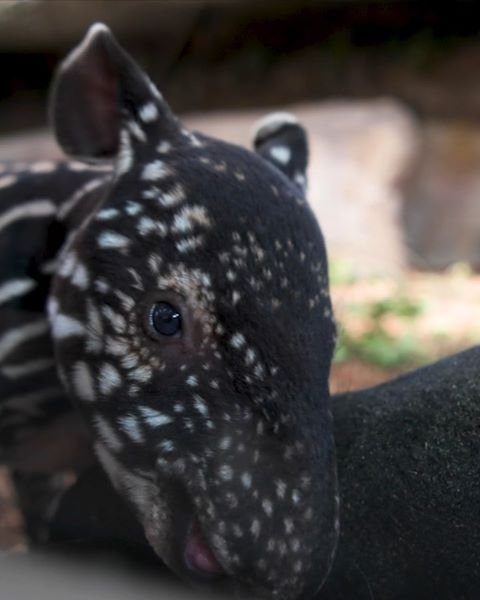
You might picture a tapir as something strange and out of place, like a mix between a pig and an anteater. But here’s the thing: these gentle herbivores have their own unique charm and play an essential role in their ecosystems. So, grab your favorite beverage, and let’s chat about why tapirs are often misunderstood.
Myth 1: Tapirs Are Related to Pigs
A lot of folks assume that tapirs are closely related to pigs because of their stout bodies and short legs. Honestly, that’s a common misconception! While they might look a bit like pigs, tapirs are actually more closely related to horses and rhinoceroses than to pigs at all. Surprising, right?
Tapirs belong to the family Tapiridae, while pigs belong to a completely different family called Suidae. This means that even though they share some physical traits, their evolutionary paths are quite distant. The tapir’s unique features, like its elongated snout and strong limbs, help it thrive in the forests and wetlands of Central and South America.
The next time someone mentions that tapirs are just “fat pigs,” you can confidently correct them. It’s a perfect example of how appearances can be deceiving!
Myth 2: Tapirs Are Dangerous to Humans
You might be wondering if tapirs are dangerous creatures, given their size and appearance. Here’s the thing: tapirs are generally quite shy and peaceful animals. They would much rather avoid confrontation than get into a scrap with a human or another animal.
Tapirs are herbivores, meaning their diet consists mainly of leaves, fruits, and plants. They spend most of their time munching on vegetation in the forest, completely uninterested in causing trouble. In fact, they often prefer to keep a low profile, hidden away in dense foliage. While they can defend themselves if threatened, attacks on humans are extremely rare.
So, rest easy knowing that encountering a tapir in the wild is more likely to leave you with a sense of wonder than fear.
Myth 3: Tapirs Are All the Same
You might think there’s just one kind of tapir, but that’s not the case at all! There are actually four different species of tapirs, each with its own unique characteristics. The most well-known are the Brazilian tapir, Baird’s tapir, Malayan tapir, and the Mountain tapir.
– Brazilian tapirs are the largest and are found predominantly in South America.
– Baird’s tapir roams Central America.
– Malayan tapirs are the only species found in Asia, sporting their distinctive black-and-white coloration.
– Mountain tapirs are unique to the Andes, often found at high elevations.
Each species has adapted to its environment in interesting ways. For instance, while the Brazilian tapir prefers dense tropical forests, the Mountain tapir has adapted to cooler, high-altitude habitats. This diversity among tapirs showcases how adaptable these creatures are.
Myth 4: Tapirs Can’t Swim
If you’ve been led to believe that tapirs are clumsy land animals that shy away from water, think again. These creatures are actually quite the swimmers! Tapirs have a natural affinity for water and are excellent at navigating rivers and streams.
They can hold their breath for several minutes while swimming and even use their snouts as snorkels to breathe. In fact, they often take a dip to cool off or evade predators. Swimming is not just a skill; it’s an essential part of their lifestyle. They often use water to find food, as many fruits and plants float or grow in aquatic environments.
So, if you ever spot a tapir lounging in water, it’s just enjoying life—like the rest of us on a hot day!
Myth 5: Tapirs Have No Role in Their Ecosystem
Some might think tapirs are just hanging out, doing their own thing, with no real purpose in the ecosystem. But here’s the scoop: tapirs play a crucial role as seed dispersers. As they munch on fruits and plants, they help spread seeds through their droppings, contributing to forest regeneration.
This seed dispersal is essential for maintaining healthy ecosystems. It helps sustain plant diversity and promotes the growth of new trees. So, when you think about tapirs, remember that they’re not just adorable animals; they’re vital players in keeping their habitats thriving.
This ecological role highlights why it’s so important to protect tapirs and their habitats. When an animal is removed from its ecosystem, it can lead to unforeseen consequences, like fewer trees and diminished wildlife diversity.
Myth 6: Tapirs Are Extinct
One of the more troubling myths is that all tapirs are extinct. While it’s true that some species are endangered, all four tapir species are still alive and kicking. However, their populations are declining due to habitat loss, poaching, and climate change.
It’s a serious issue. Conservation efforts are in place to protect these marvelous animals, and many organizations are working hard to preserve their natural habitats. If you want to help, many organizations allow you to support tapir conservation through donations or volunteering.
Let’s be clear—while tapirs aren’t extinct, they do need our attention and care. Every bit of effort can make a significant difference in ensuring they thrive.
Myth 7: Tapirs Don’t Make Good Pets
Now, you might think it would be cool to have a tapir as a pet. But the truth is, tapirs are wild animals and are not suitable for life in captivity. They thrive in their natural habitats, where they can roam freely and follow their instincts.
Keeping a tapir as a pet could lead to behavioral issues and stress for the animal. They require specific diets, environments, and social structures that are hard to replicate in a home setting. Plus, owning a tapir is illegal in many places due to wildlife protection laws.
So if you ever considered bringing a tapir home, it’s best to admire them from afar. You can appreciate these unique creatures in their natural surroundings or through reputable wildlife parks and sanctuaries.
As we wrap up our exploration of common myths about tapirs, remember that these fascinating animals deserve our respect and understanding. Whether you’re a nature lover or just curious about wildlife, tapirs offer a glimpse into the incredible diversity of life on our planet. By debunking these misconceptions, we can help ensure a brighter future for tapirs and the ecosystems they inhabit.

